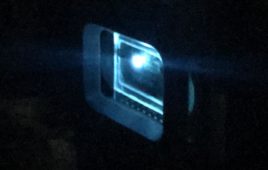 In modern microscope imaging techniques, lasers are used as light sources because they can deliver fast pulsed and extremely high-intensity radiation to a target, allowing for rapid image acquisition. However, traditional lasers come with a significant disadvantage in that they produce images with blurred speckle patterns — a visual artifact that arises because of a property of traditional lasers called “high spatial coherence.” These speckles greatly reduce image quality in wide-field microscopy, a common technique for making broad swath images of the whole side of a cell or some other part of the microscopic world in order to understand its intricate inner workings.
In modern microscope imaging techniques, lasers are used as light sources because they can deliver fast pulsed and extremely high-intensity radiation to a target, allowing for rapid image acquisition. However, traditional lasers come with a significant disadvantage in that they produce images with blurred speckle patterns — a visual artifact that arises because of a property of traditional lasers called “high spatial coherence.” These speckles greatly reduce image quality in wide-field microscopy, a common technique for making broad swath images of the whole side of a cell or some other part of the microscopic world in order to understand its intricate inner workings.
To solve this problem, scientists have sought a laser-like light source with “low spatial coherence.” Low spatial coherence means that the electric fields at different positions in the light beam do not oscillate in lockstep, unlike traditional lasers.
Now a team of researchers at Texas A&M University has done just that, demonstrating for the first time that a newly emerging technique known as random Raman lasing emission can produce a bright, speckle-free, strobe light source with potential application in high-speed wide-field microscopy.
“The random Raman laser is unlike any existing laser light source,” says Brett Hokr, a physicist at Texas A&M University who led the research. “We found that random Raman lasing emission has a low level of spatial coherence. The emission can be used to produce a wide-field speckle-free quality image with a strobe time on the order of a nanosecond. This new, bright, fast, narrowband, low-coherence light source opens the door to many exciting new applications in bio-imaging such as high-speed, wide-field microscopy.”
Random Raman lasing causes a diffuse material such as a powder to emit laser light. Different from traditional lasers that work by bouncing photons back and forth in a laser cavity, random Raman lasing happens when the light bounces among the powder particles long enough for amplification to occur.
According to Hokr, random Raman laser emission is a pulsed emission with a temporal duration on the scale of single nanoseconds and in a narrow spectrum of about 0.1 nanometer, which can emit a million times more photons per unit time per unit wavelength than any other conventional light source, and should have sufficient intensity to allow scientists to acquire a full two-dimensional fluorescent image in a single pulse of the laser.
Hokr’s team conducted the first spatial coherence measurement of the random Raman laser in two ways — initially using a classic set-up known as Young’s double slit experiment. Barium sulfate power was pumped with 530 microjoule, 50 picosecond laser pulses to generate random lasing that later passed through a double slit, and the team captured images of the interference patterns.
The researchers observed that those interference patterns were barely discernible, indicating a very low degree of spatial coherence. To further quantify the overall spatial coherence, they measured something known as the speckle contrast ratio, which gauges the statistical properties of the emission. These measurements were consistent in confirming the presence of a low level of coherence.
To further demonstrate that this low coherence truly leads to a speckle-free image, the researchers produced a full-frame, speckle-free microscopic image showing the formation of a cavitation bubble from melanosomes from a several-nanosecond laser pulse at 1064 nanometer radiation.
Release Date: May 4, 2015
Source: The Optical Society


